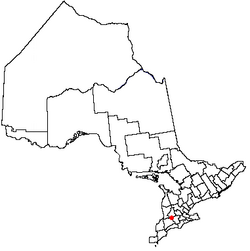St. Marys, Ontario
43°15′32″N 81°08′35″W / 43.25889°N 81.14306°W
Town of St. Marys | |
|---|---|
| Nickname: The Stonetown | |
| Motto: The Town Worth Living In | |
 | |
| Country | Canada |
| Province | Ontario |
| County | Perth County |
| Established | 1844 |
| Incorporated | 1864 |
| Government | |
| • Mayor | Jamie Hahn |
| Population (2001)(1) | |
| • Total | 6,293 |
| Website | http://townofstmarys.com/ |
St. Marys is a town in southwestern Ontario, Canada. It is located on the River Thames southwest of Stratford in County of Perth. St. Marys has a population of 6,293 as of the 2001 Census.[1] The town is also known by its nickname, "The Stone Town", due to its many structures rendered in local limestone.
It is the burial place of Arthur Meighen, Canada's 9th Prime Minister. Timothy Eaton, who went on to become one of Canada's greatest retailers, opened his first businesses in Canada in St. Marys and nearby Kirkton, Ontario.
St. Marys is home to the Canadian Baseball Hall of Fame.
History
The first settlers arrived in St. Marys in the early 1840s, attracted by the area's natural resources. At the new town site, the Thames River cascaded over a series of limestone ledges, providing the power to run the first pioneer mills and giving the community an early nickname: Little Falls.
In the riverbed and along the banks, limestone was close to the surface and could be quarried for building materials. Many 19th century limestone structures survive: churches, commercial blocks, and private homes. They have given St. Marys its current nickname: Stonetown.
The coming of the Grand Trunk Railway in the late 1850s spurred growth and soon St. Marys became a centre for milling, grain-trading and the manufacture of agriculture-related products. The railway connected the town to the rest of the world and framed the local landscape with its two large trestle bridges on limestone pillars across the waterways.
Attractions
St. Marys contains many 19th century buildings built with locally quarried limestone. Notable buildings include the Opera House built in 1880, the spired municipal Town Hall built in 1891, and the Public Library built in 1904.
The Canadian Baseball Hall of Fame moved to St. Marys from Toronto in 1994 and opened in 1998. It is dedicated to preserving Canada's baseball heritage. Since opening, 75 members (46 players, 23 builders, 2 honorary, 4 honorary teams) have been inducted. It includes professional ballplayers, amateurs, builders and honorary members who have helped popularize the sport in Canada. The facility also includes a baseball field designed by landscape architect Art Lierman of London, Ontario.
The Grand Trunk Trail is a walkway transformed from a two kilometre section of the former Grand Trunk Railway line. The trail features a walk over the restored Sarnia bridge, providing panoramic views over the town.
The Quarries consist of two former limestone quarries located in southern St. Marys, one of which has been rehabilitated as an outdoor swimming pool. The area became a popular swimming spot with locals after filling with water between 1930 and 1935. In 1945 the town bought the quarries along with 50 acres of surrounding land, and now manages it as a public recreational facility.
Sports
The St. Marys Lincolns are a member of the OHA Junior "B" Hockey Association and play in the Western Junior "B" Hockey League. Prior Lincoln team members who played with the NHL include Terry Crisp, Don Luce, Steve Shields and Bob Boughner.
Notable people
- Arthur Meighen - Canada's 9th Prime Minister
- Timothy Eaton - Founder of Eaton's department store
- Tracy Brookshaw - professional wrestler for Total Nonstop Action Wrestling
- Dr. Albert Edward Berry - Canadian Environmentalist
- Mark Bell - Professional Hockey player with the NHL
References
- ^ Statistics Canada St. Marys, Ontario For population information and statistics.

